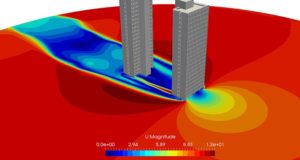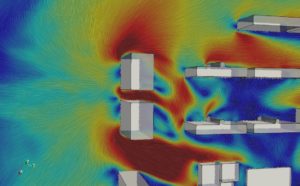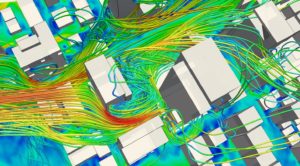Whoosh!
The design and construction of a new building or urban area is a highly complex project, which needs to take into account a plethora of considerations, including safety, durability, aesthetics, energy efficiency, sustainability and cost-effectiveness.
One critical concern is pedestrian wind comfort. The fact that a new structure impacts the microclimate in its vicinity makes wind engineering a serious application to pay attention to for many architects, civil engineers and urban planners.
Depending on its shape, height and location, a building can have a positive or negative impact on wind direction, wind speed, radiation, air pollution and more. Increased wind speeds, for example, is a common phenomenon that appears at the pedestrian level around a high-rise or buildings characterised by a complex shape.

Flatiron Building, New York City
A famous example is the Flatiron Building, in New York City, between East 22nd and East 23rd streets. The building splits Broadway and Fifth Avenue and sits at the end of an open passageway created by Madison Square Park, in the north. Due to the geography of its location, the wind currents around the building can be treacherous. The layout of the area, combined with the shape of the building, can create unpredictable gusts of wind, which are uncomfortable for pedestrians. This is actually one of the reasons the building has become so famous since its construction in 1902. The building had raised fears that the structural system would not be able to endure the wind loads, but this has not been the case. The engineers designed it to endure winds four times stronger than are generated on site. Owing to the building’s shape, wind currents from the leading edge of the building move in a vortex pattern in both up and down directions. Nevertheless, pedestrian wind comfort does remain an issue for the iconic building and is a lesson for all new construction projects.
Along with pedestrian comfort, wind safety is even more important, with reports showing cases of serious injuries and even deaths caused by high wind speed in urban areas.
In most countries, construction projects require compliance with a wind engineering standard, such as NEN 8100 for wind nuisance and ASCE 7 for wind loads.

Assessment of pedestrian wind comfort with online CFD simulation (Source: SimScale)
In complying with these standards and ensuring pedestrian safety and comfort, engineering solutions are indispensable. Wind tunnel testing and numerical simulation with CFD are the tools used to investigate wind flow around a building configuration or a built-environment.
Wind effects to consider in urban planning
The most important considerations and wind effects in assessing pedestrian wind comfort are corner acceleration, Venturi or channeling effect, downwash effect and passages.
The corners of buildings are the regions that can create the highest discomfort in a built-environment, especially if high-rise buildings are present. The phenomenon of corner acceleration is caused by sharp building shapes, which can cause accelerations around the corners even for oblique winds. Further effects, like the side vortices, can be created from the difference in pressure between the front (with high pressure) and the sides (with low pressure) of the building. In these regions, wind engineering experts recommend not placing any gardens or public spaces, to ensure wind comfort and safety.

CFD simulation showing an example of corner acceleration around buildings (Source: SimScale)
The Venturi effect (or channeling effect) is the reduction in wind pressure, which happens when wind flows through a constricted area between two buildings, which results in wind acceleration through this channel. This effect can create high winds, which can be unsafe for pedestrians.

CFD simulation showing an example of Venturi or channeling effect between buildings (Source: SimScale)
The downwash effect is mainly caused by tall buildings, which capture winds at higher levels and redirect them to the ground. This causes a three-dimensional flow moving downwards and often creating a large recirculation at the ground level, together causing increased wind activity.
The fourth effect, passages, can create a high amplification factor and a strong wind jet, which forms when the flow with high pressure from the stagnation side tries to escape through the passage.

CFD simulation showing an example of downwash and another 3D effect between buildings (Source: SimScale)
This article presents a comparison between a CFD simulation study, created by online simulation provider SimScale and experimental results taken from the Guidebook for Practical Applications of CFD to Pedestrian Wind Environment around Buildings, published by the Architectural Institute of Japan (AIJ) in 2008. The guidebook sets the standards for cross-comparison between the results of CFD predictions, wind tunnel tests and field measurements, and is helpful in determining the accuracy of CFD codes for pedestrian wind comfort assessments.

Wind comfort validation study with SimScale online CFD simulation (Source: SimScale)
Conclusion
With the construction industry constantly growing, technological advancements are the driving force behind better urban designs, dedicated to a higher standard of living and increased comfort for residents and pedestrians.
Wind engineering is integrated into a multidisciplinary approach to building design and construction projects. In this set-up, CFD simulation and wind tunnel studies are key solutions in ensuring pedestrian wind comfort and safety. With the emergence of cloud-based simulation software, this technology is becoming more accessible than ever before. Right on time for a new era in urban planning – the future is now.
The writer is Team Manager, Application Engineering, SimScale.


